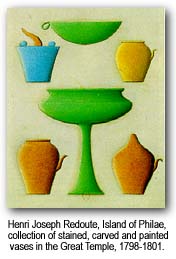The Temple of Isis at Philae
(the Temple of Isis and Horus the Child, Harpocrates)
Beyond the Vestibule of Nectanebos I at Philae, the western colonnade follows that edge of
the island and is the most complete. Here, no two capitals are the same, while the eastern
colonnade, even after 800 years of building, was never completed. There are several
structures just outside the eastern colonnade. Outside the Southern end is the ruins of a
Temple of Arenanuphis. Midway is the Chapel of Mandulis, and at the Northern end of the
colonnade is a Temple of Imhotep, which is very complete and has Images on the forecourt
walls depict Ptolemy IV before Imhotep along with other gods including Khnum, Satet,
Anukis, Osiris and Isis.
 Cartouche, but now only a pair of granite lions remain. On the east side
of the pylon and set at a right angle to it is the gate of Ptolemy II. Upon the facade of the pylon
are traditional scenes of battle and offering. They include images of Ptolemy XII Neos
Dionysos, Hathor, Horus of Edfu, Unnefer (Osiris after his resurrection), Isis and Harsiesis.
The western Pylon is split, allowing entrance to the mamissi (birth house). The rear of the first
pylon has images of priests carrying Isis’ barque. Cartouche, but now only a pair of granite lions remain. On the east side
of the pylon and set at a right angle to it is the gate of Ptolemy II. Upon the facade of the pylon
are traditional scenes of battle and offering. They include images of Ptolemy XII Neos
Dionysos, Hathor, Horus of Edfu, Unnefer (Osiris after his resurrection), Isis and Harsiesis.
The western Pylon is split, allowing entrance to the mamissi (birth house). The rear of the first
pylon has images of priests carrying Isis’ barque.
Inside the first pylon there is a Birthouse (Mamissi) to the left and quarters for the priests and
guards to the right. Birth Houses became important after Hatshepsut’s depiction at Deir el
Bahri of her divine birth. It then became popular for each pharaoh to legitimize his rule by
demonstrating his descent from Horus. The birth house in this temple serves that purpose,
and is similar to those at Dendera and Edfu. A pronaos leads into three rooms consisting of
two vestibules and the sanctuary. There are traditional scenes of Isis the Elder being
worshipped by the mother of Hathor in the second vestibule. It is interesting that on the inside
of the back wall are scenes of Horus wearing the double crown rising up in triumph, while on
the outside of this same wall are images of Isis nursing the infant Horus in the swamp. Around
the birth house are colonnades . Here, one will find inscriptions dating from Euergetes II,
Neos Dionysos, Augustus and Tiberius. On the shore of the island closest the Birth House is a
Nilometer.
On the east wall of the forecourt are images showing the King dragging the barque of Soker,
and behind the wall are four rooms believed to have been used by either priests or guards. A
fifth room is called the library and has Baboon and ibis forms of Thoth.
 align=right hspace=0 width=176 height=259>The second Pylon is offset to the east of the first and angled so
as to change the axis of the structure. In eastern front of the
pylon is a small Roman Chapel, with inscriptions of Ptolemy IV
behind. The pylon entrance leads into a hypostyle hall of typical
style for the Ptolemaic period. The columns are of high quality
with fine workmanship. There are images on the ceiling depicting
the vulture of Upper and Lower Egypt, and the barques of night
and day. align=right hspace=0 width=176 height=259>The second Pylon is offset to the east of the first and angled so
as to change the axis of the structure. In eastern front of the
pylon is a small Roman Chapel, with inscriptions of Ptolemy IV
behind. The pylon entrance leads into a hypostyle hall of typical
style for the Ptolemaic period. The columns are of high quality
with fine workmanship. There are images on the ceiling depicting
the vulture of Upper and Lower Egypt, and the barques of night
and day.
The hall leads into three antechambers, which then lead into the
Sanctuary. There is a pedestal that once supported the royal
barque of Isis, dedicated by Ptolemy III and his wife, Bernice. In
the first antechamber there is a staircase which leads to the
Chapel of Osiris, where there are religious ritual scenes depicting
Osiris, as well as Isis, Nephthys and Osiris-Wenennefer and in an inner room, scenes of the
resurrection of Osiris with Horus, Nephthys, Selket, Douait and Sokar, all gods related to that
myth.
|





